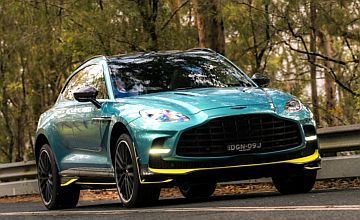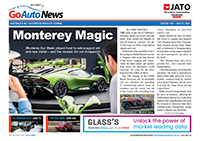Make / Model Search
OptionsCar reviews - Aston Martin - DBX707Aston Martin modelsOverviewWe like Seriously sexy styling (for an SUV), endless V8 grunt, telepathic air suspension, dynamic prowess that belies its heft, superb interior finish Room for improvement Not much, other than the clunky, outdated infotainment system Hulking Aston SUV shocks the senses with supercar performance, but it’s comfy too27 Jan 2025 Overview
A few years ago, Aston Martin decided that its potent entry into the ultra-premium SUV market, the DBX, just wasn’t fast enough, so it went and released the even more powerful DBX707.
The base model produced a stout and respectable 405kW/700Nm, before the DBX707 eclipsed it with a stratospheric 520kW/900Nm – winning the title of ‘most powerful SUV’ and ultimately killing off its stablemate.
The DBX707 has proven so popular since then that Aston is now dropping the all-too-suburban base model from its lineup – so it’s the 707 or nothing if you want an Aston that’ll seat five without complaints.
And in case the DBX707 isn’t quite showy enough, the AMR23 we’re testing is a motorsport-inspired special edition that scores lashings carbon fibre and the same colour scheme as the Aston Martin Aramco Cognizant Formula One racer – for a price north of half-a-million, we’re told.
Aston Martin’s bespoke Q division finished the AMR23 edition in rich ‘Podium Green’ paint, flanked by carbon fibre aero bits and fluorescent lime accents. Of course, there’s plenty of AMR badging, to remind you (and others) that this is a very special (and expensive) Aston.
When we say showy, by the way, we mean it in the nicest way possible because compared to other awkwardly overdone performance SUVs out there (cough, Urus), the Aston remains a classy affair.
Aston Martin’s design team started with a fresh slate for the DBX, rather than giving an existing SUV the boy-racer treatment as seems to be the norm in the performance SUV space.
The largest of Aston’s offerings plays in a fairly small field of competitors, up against the Porsche Cayenne Turbo GT, Lamborghini Urus Performante, Audi RSQ8 and Bentley Bentayga – yet it feels more unique than the rest. And in our opinion, it looks the best, too.
In terms of the powertrain, it’s an AMG affair top to bottom, front to back, but that’s a very good thing.
The engine is actually the same 4.0-litre twin-turbo V8 unit used in the AMG GT, albeit even more powerful, fed through a wet-clutch AMG nine-speed ‘box.
Given it’s the most powerful engine ever shoehorned into an SUV, we didn’t expect it to drink in moderation. We weren’t let down.
The force-fed V8 consumed 22.7L/100km across the first three days of use, with plenty of rocket-up-to-speed takeoffs to ‘test’ the car, while the second half of the week returned a reasonable 18.2L/100km.
Our take on the fuel use, however, is simple: who cares, because Aston buyers won’t.
Driving Impressions
The Jekyll and Hyde characteristics we’ve come to expect of ultra-premium performance SUVs – as they try and strike an impossible balance between comfort, performance and practicality in a body shape that was never meant to go fast – don’t apply to the DBX707.
Sure, it’s blisteringly quick, but a quick look at the spec’ sheet, with its claimed 3.3-second 0-100km/h time, could tell you that much. It’s how the Aston does it that’s impressive.
The DBX707 still feels every bit like a two-plus-tonne wagon as it squats and squirms under hard acceleration, whether it’s in Sport+ or simply the middle-ground Dynamic drive mode (our favourite).
We suspect Aston Martin didn’t push the air suspension system to its limit of stiffness, opting for a little squat-and-go drama instead, because this is not an SUV that pretends to be a car.
It actually reminded me of a modified (to the tune of 900hp) Jeep Trackhawk I drove a few years ago, in terms of the theatrical acceleration.
Much of that comparison is because the DBX707 doesn’t feel ‘effortlessly fast’ like so many high-powered euros, instead making a bit of a song and dance about what it can do.
Unlike a Trackhawk, though, the DBX707 also turns corners.
Despite its fore-aft playfulness, a trait we never thought we’d attribute to an SUV, the DBX707 comes alive on a winding b-road, with long sweeping corners proving its preferred stomping ground.
Not a razor-sharp rocket for tight mountain roads, but more of a big-power bruiser for when the road opens up, the DBX sits flatter and offers more grip in corners than it ought to – but it does remind you it's a heavy chap when pushed.
It rides on sizable Pirelli P-Zero rubber, measuring 325mm wide at the rear and 285mm wide up front, but still shouldn’t hook up quite as well as it does when accelerating through and out of corners.
This, we think, is the result of a smart centre diff that sends most of the torque to the rear axle when encouraged to, with loads of raw mechanical grip on offer and predictable oversteer when you choose to prod the beast.
A trend in this segment is mega brakes and the DBX707 is no exception, with enormous carbon-ceramic stoppers gripping rotors bigger than you’d find on most race cars – leaving virtually no negative space within the 23-inch alloys.
Stomp on the brake pedal and, yep, the G-force easily exceeds that which the DBX produces under hard acceleration. You can use all of the accelerator pedal’s travel if willing, but never on a public road will the full braking force of this car be required.
It’s also a pleasant place to be, driving characteristics aside, which is why we think the DBX707 could actually serve as an everyday SUV.
Inside the cabin, the DBX features an astonishing amount of carbon fibre, which we’d normally find a little tacky if not for it being balanced out beautifully by soft black leather that smells as luxurious as it looks.
The switchgear is pleasantly analogue, too. Gear selector buttons sit high on the dash, while ride height adjustability, drive modes, exhaust settings and more are adjusted using dials and buttons housed within a carbon-fibre centre console.
What lets it down, though, is a seriously outdated screen (not a touchscreen) that uses the old Mercedes-Benz haptic controller and it really doesn’t like smartphone mirroring.
It seems customers, and probably potential customers, had similar complaints because Aston has since moved to a large touchscreen setup that appears to have corrected the only real gripe we could find with this car.
For day-to-day suburban use, be warned: the DBX707 is positively massive.
It’s bigger than it looks, at more than five-metres long and around two-metres wide. It is, however, fairly low, especially with its air suspension dropped to the lowest ride height.
By the time you do wrangle the big Aston into a parking spot, choosing carefully which cars (and owners) you trust not to bump or scratch it, it’s a car you turn to check out one more time.
It’s got to be the best looking SUV made so far and, as a bonus, it performs, rides and charms like nothing else in its orbit.  All car reviews Alfa Romeo Alfa Romeo Abarth Abarth Audi Audi Aston Martin Aston Martin BMW BMW Bentley Bentley Chrysler Chrysler Chevrolet Chevrolet Dodge Dodge Citroen Citroen Ferrari Ferrari DS DS Ford Ford Fiat Fiat FPV FPV Foton Foton Haval Haval Great Wall Great Wall Honda Honda Holden Holden Hyundai Hyundai HSV HSV Isuzu Isuzu Infiniti Infiniti Jaguar Jaguar Iveco Iveco Kia Kia Jeep Jeep Land Rover Land Rover Lamborghini Lamborghini Maserati Maserati Lexus Lexus McLaren McLaren Mazda Mazda Mercedes-Benz Mercedes-Benz Mitsubishi Mitsubishi Mini Mini Opel Opel Nissan Nissan Porsche Porsche Peugeot Peugeot Ram Ram Proton Proton Rolls-Royce Rolls-Royce Renault Renault Skoda Skoda Saab Saab SsangYong SsangYong Smart Smart Suzuki Suzuki Subaru Subaru Toyota Toyota Tesla Tesla Volvo Volvo |
OptionsClick to share
|









Facebook Twitter Instagram